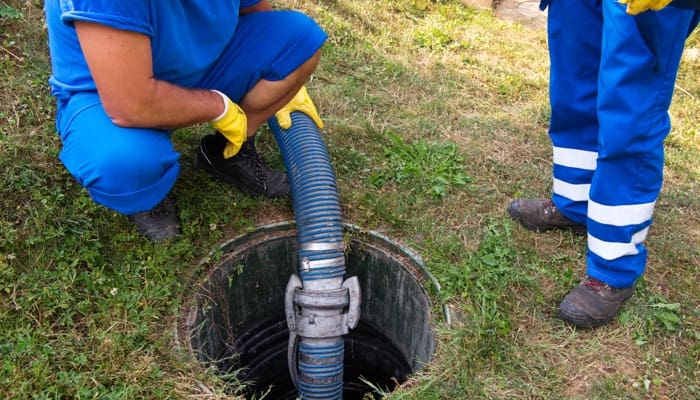Selling a House With a Septic Tank: No Sewer, No Problem!
- Published on
- 3 min read
-
 Valerie Kalfrin Contributing AuthorClose
Valerie Kalfrin Contributing AuthorClose Valerie Kalfrin Contributing Author
Valerie Kalfrin Contributing AuthorValerie Kalfrin is a multiple award-winning journalist, film and fiction fan, and creative storyteller with a knack for detailed, engaging stories.
It’s time to put the house on the market, and you’re nervous about how buyers will perceive the septic tank—your property’s means of wastewater treatment. However, home sales involving septic tanks are par for the course. In fact, 1 in 5 households nationwide depend on a septic system to treat and dispose of their wastewater, as opposed to a centralized public sewer system.
“For the most part, unless you have a situation where you have a tremendous amount of tree roots that have somehow gotten into the drainfield, or maybe the system’s 35 to 40 old and never been maintained properly, probably 95% of the time, we really don’t have any issues with septic tanks,” says Robert Ryczek, a top-selling real estate agent for 41 years in the Gainesville, FL area.
We’ll help you allay any concerns over selling a house with a septic tank with all the details you need on how to keep up the system’s maintenance, obtain the proper inspections, and provide the required disclosures to get to closing smoothly.

‘Septic tank and well water go hand in hand’
While there are buyers out there who don’t want to have to deal with a septic tank or well water, those scouting certain properties understand that a septic tank goes with the territory.
In fact, buyers looking for other features your home has—such as a rural setting with large acreage—may anticipate having a septic tank and a well on the property.
“Maybe they want an acre of land, or they just want to be away; maybe they’ve got horses,” Ryczek says. “They’re pretty accustomed to and they understand that a septic tank and well water goes hand in hand.”
Nevertheless, to help prevent any problems with your sale, it’s best to understand how a septic tank or septic system works.
What are the different types of septic systems, and how do they compare to a public sewer?
Septic systems fall under a variety of names, including:
- private sewage systems
- individual sewage disposal systems
- cluster systems
- decentralized wastewater treatment systems
- on-lot systems
- package plants
- onsite wastewater treatment systems
Regardless of what it’s called, this system is an underground wastewater treatment structure for housing and businesses that aren’t connected to a public or centralized sewer system.

What type of maintenance is required to keep the septic tank in selling condition?
All the wastewater we use—from the bathroom, laundry, and kitchen—needs to be treated to remove or neutralize pathogens and pollutants like phosphorus and nitrogen, according to the Environmental Protection Agency (EPA). In a centralized sewer system, sewer mains flow into progressively larger pipes until they reach a wastewater treatment plant; with a private septic system, this treatment occurs on the property.
A typical septic system consists of a main drainage pipe, a septic tank and a drainfield, or soil absorption field. Systems can have additional components such as pumps and electrical float switches.
The septic tank is often a concrete, fiberglass, or polyethylene watertight container buried underground. It separates any solids, organic matter, and floatable material (such as oils and grease) from the liquid wastewater, which exits into the shallow drainfield. From the drainfield, the treated wastewater disperses through the soil, ultimately discharging to groundwater. The separated solids and sludge remain in the tank until they’re removed by a professional septic service.
The National Environmental Services Center (NESC) at West Virginia University in Morgantown, W.Va., says that solids take about 24 to 48 hours to settle. A four-bedroom home with a 1,000-gallon tank typically would need about two days for solids to settle—but as more solids accumulate, the settling time decreases. More than one-third of the liquid depth, and the tank should be pumped and cleared.
Problems can occur when the tank is overdue for drainage or when the drainfield becomes overloaded, causing flooding or sewage to flow into the ground or back into the home, these experts say.
The EPA recommends that you have your household septic system inspected at least every 3 years and pumped every 3 to 5 years, depending on the size of your household, the septic tank, and other factors.
(If your system has mechanical components or additional pumps, the EPA suggests an annual inspection.)
Are sellers required to disclose a home’s septic tank system?
The short answer is generally yes—sections about a home’s water treatment systems are common on individual state real estate disclosure forms but may vary in the details you’re prompted to provide in writing to the buyer.
Take the example below from Colorado’s Seller’s Property Disclosure that asks about the type of sanitary sewer service on the property, the date of the latest Individual Use permit, the date of the last inspection and the date of the last pumping.

Minnesota has a specific section that requires sellers to disclose the location and type of well on a property, even when these facilities are not in use or have been sealed.

Other states do not have a standard disclosure form but instead employ the “Caveat Emptor” Rule, saying that sellers and agents must disclose anything that would impact the buyer’s health or safety.
To find out what disclosures about septic and sewer systems are required when selling real estate in your state, check out our list of all 50 states’ individual real estate disclosure forms.
However, formal real estate disclosures aside, real estate experts advise sellers to err on the side of full disclosure to avoid opening the door to any legal scuffles down the road. Something as critical as a home’s wastewater system is not something that you’d want to intentionally hide from a buyer.
Is the seller required to get a septic tank inspection before closing?
Your real estate agent will know best if this is a requirement of sale in your state. “Recently, over the last few years, mortgage companies have begun insisting upon a septic tank inspection so that they can check off, just as they do with other issues, maybe a problem with the home,” Ryczek said.
If the seller can show documentation that the tank has been pumped and serviced recently, then an inspection might not be necessary, he said.
A home inspector, although not a septic professional, also might request a septic system inspection if they notice some “telltale signs” of trouble, Ryczek said, such as slow-flowing toilets or backflow in the drains.
“We’d always ask those questions: has it been serviced? What’s the latest? Sometimes in a house that’s maybe 30 years old, they’ll be quick to tell you that they’ve had the drain filled, re-dug out and replaced—that’s typically a pretty expensive venture,” Ryczek added. “But it kind of goes to, Has there been service done or has it been ignored for the last umpteen years?”

What does a septic system inspection involve, and how much does it cost?
A qualified private contractor typically inspects septic systems. Some local health departments do as well for a fee; others will refer homeowners to appropriate wastewater professionals, the NESC says.
Small business sites such as Angie’s List or Thumbtack also provide searchable databases of professionals in your area.
A typical inspection involves determining the location of the underground tank, either with the help of a sketch of the system from the permitting process or by flushing a small radio transmitter—about the size of a small pill bottle—down the toilet. The inspector removes the transmitter after locating the tank. (Depending on the location of your septic tank, you may be able to uncover and open it yourself, reducing the inspection fee, the NESC says.)
An inspector then measures the level of solids in the tank with a long, hollow pole called a Sludge Judge and checks the tank’s other components.
An inspection can take about two to two and a half hours, according to Thumbtack. Depending on your home’s location, most inspections cost $100 to $250. Add an additional $50 to $250, based on the depth of the tank, if the inspector has to uncover the tank.
That’s a negligible cost considering the potential price of repairs. Replacing a drainfield can run from $2,500 to $10,000, Thumbtack says.
Some companies will offer special pricing, such as $75 for a septic diagnostic test.

Does a home septic tank change the way an agent markets a home for sale?
In his experience, Ryczek says that buyers venturing outside city limits frequently know that a septic system comes with the territory. He doesn’t do anything extra to market the home unless the seller has just replaced or updated any components to “give someone assurances to know that ‘gee, I should be good for another 20 years on these things.’”
That said, if your home’s landscaping has been designed with the septic system in mind, that’s a great selling point. A rectangular mound rising 18 inches to 5 feet above a flat landscape may be noticeable and unsightly, the NESC says.
However, other placement can allow the mound to serve as a privacy barrier or a windbreak for the home—and provide a sustainable landscape with high aesthetic value, lower maintenance costs, and greater environmental benefits.
Herbaceous plants such as wildflowers and grasses have fibrous root systems, for instance, which can prevent erosion around the mound and provide dense but attractive cover. A professional landscaper can advise you as to which plants work best in this situation, but in general, you can frame the mound at a distance with trees and shrubs and use plants that work well in dry soil—nothing edible—near the tank.
How to sell the house, septic tank and all!
Selling a home with a septic tank doesn’t have to be a headache, especially if you’ve paid attention to the maintenance. Plus, if you’re aiming for buyers searching for a quieter lifestyle, they may already expect to get a chat about where the wastewater goes out of their system.
Have a discussion with your agent about any steps you need to take for your individual house and septic system—it’s really as simple as that—and you’ll be well on your way to a successful home sale.
Header Image Source: (Joyce Huis/ Unsplash)
